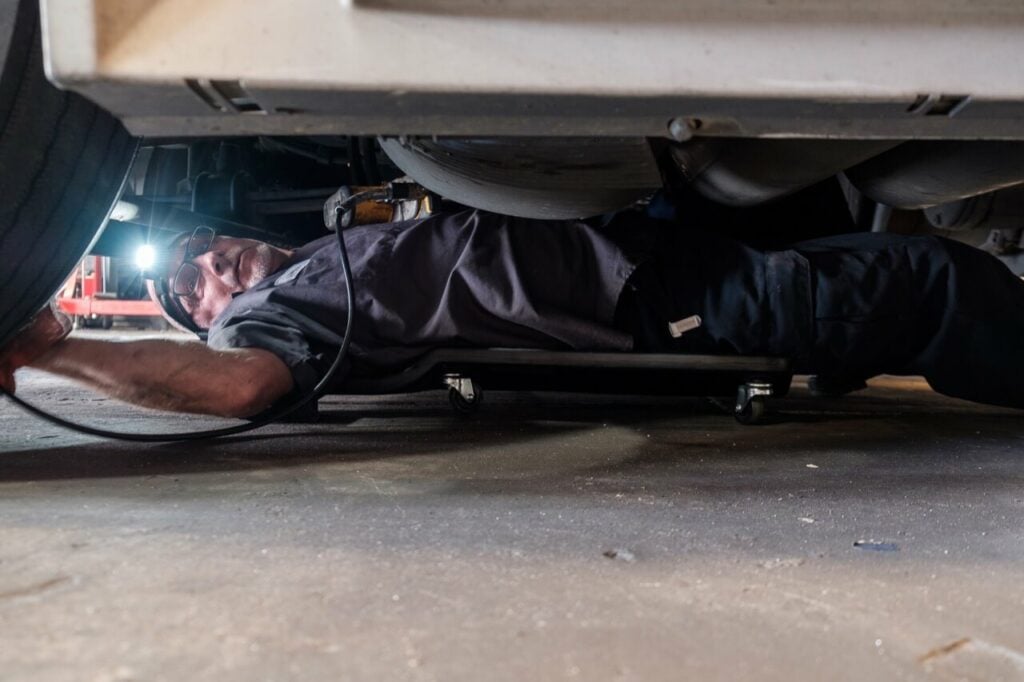Complete Brake Inspection & Service
Complete brake service and inspection should include a hydraulic brake test, a power-assist system check, and a CVIP or DOT brake tire/calliper examination. We recommend that you have any grinding or squealing noise checked by a professional mechanic to determine if it is caused by an improperly adjusted brake shoe rubbing against the rotor or drum. If this is the case, then the brake shoe will need to be replaced.

Brake Replacement
Brake replacement includes rotors and drums, which are machined for flatness. If they are not flat, it will compromise your vehicle’s braking capabilities because the brakes won’t release properly. The mechanic should also check discs or pads for damage or defects that might cause the brakes to fail.
About Air Brake Service
Air brakes, sometimes called air-hydraulic brakes, are used on heavy trucks and locomotives. As the name implies, the air brake system uses compressed air as the operating force for stopping vehicles or equipment.
A foot pedal in the driver’s cab activates a mechanism that opens pressurized air valves in each of the truck’s axle groups, so they release their brake shoes. The driver then uses a hand brake to control additional air pressure and applies individual brake shoes in each axle group.
Most trucks have two service brakes: power-assisted or power-brakes that use engine vacuum and compressed air. A professional mechanic should check each brake system carefully before you pull any vehicle on the road.
Common Brake Problems & Solutions for Heavy-Duty Trucks
If your heavy-duty truck has a problem with the brakes, it can be repaired by bleeding the brake lines to get rid of the air, replacing brake pads and shoes, welding up the holes in drums or rotors, or fixing worn bearings. The cost for replacement work often depends upon the mileage of the vehicle.
Usually, heavy-duty trucks have brake drums and rotors that are made from cast iron. If they are not machined, there is a chance that the drum will crack if it overheats from being filed or ground down with an abrasive wheel. Sometimes cracks won’t be visible until the mechanic uses a brake lathe machine to see cracks in the metal.
Frequently Asked Questions
Regular brake inspections are essential for ensuring the safety and reliability of your heavy-duty truck. We recommend a comprehensive brake inspection, including a hydraulic brake test and a power-assist system check, as part of your regular preventative maintenance schedule. For specific intervals, it is always best to consult your vehicle’s manufacturer recommendations and consider your typical operating conditions, as heavy loads and frequent stops can increase wear.
Brake wear is a natural result of the friction required to slow and stop a heavy vehicle. Several factors can accelerate this process, including driving habits, such as frequent hard braking, and operating conditions, like hauling heavy loads or navigating steep terrains. Environmental factors such as road salt and debris can also contribute to corrosion and wear. Regular inspections are key to identifying and addressing wear before it becomes a safety issue.
Be aware of any changes in your truck’s braking performance. Common indicators that your brakes require immediate attention include unusual noises such as squealing or grinding, a vibrating or pulsating brake pedal, or your truck pulling to one side when braking. Additionally, if you notice a decrease in stopping power or a brake warning light on your dashboard, it’s crucial to have your vehicle inspected by a certified technician.
The primary difference between air and hydraulic brakes is the method used to apply braking force. Air brakes, common in heavy-duty trucks, use compressed air to activate the braking mechanism. This system is powerful and effective for large vehicles. Hydraulic brakes, typically found in lighter vehicles, use fluid to transfer pressure from the brake pedal to the brake pads or shoes.
Scheduling Semi Truck Brake Service at Inland Truck & Equipment
To schedule service, fill out the form below or find the nearest location to you and get in touch.

